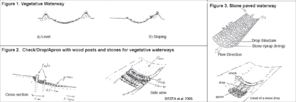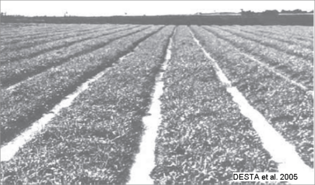Difference between revisions of "Micro-hydro Power (MHP) Projects - Mitigation and Intervention Techniques - Flood Control and Improved Drainage"
From energypedia
***** (***** | *****) (Created page with " = Overview = ► Back to the overview "[[Mitigation and Intervention Techniques Related to Micro-hydro Power (MHP) Projects|Mitigation and Intervention Techniques Related to ...") |
***** (***** | *****) |
||
| Line 1: | Line 1: | ||
| − | = Overview = | + | = Overview<br/> = |
► Back to the overview "[[Mitigation and Intervention Techniques Related to Micro-hydro Power (MHP) Projects|Mitigation and Intervention Techniques Related to Micro-hydro Power (MHP) Projects]]" | ► Back to the overview "[[Mitigation and Intervention Techniques Related to Micro-hydro Power (MHP) Projects|Mitigation and Intervention Techniques Related to Micro-hydro Power (MHP) Projects]]" | ||
| + | |||
| + | <br/> | ||
<br/> | <br/> | ||
| Line 10: | Line 12: | ||
=== Waterways (Vegetative and Stone Paved) === | === Waterways (Vegetative and Stone Paved) === | ||
| − | {| | + | {| style="width: 100%;" border="1" cellspacing="1" cellpadding="1" |
|- | |- | ||
| − | | style="width: 507px" | <u>Objectives</u>: A waterway is a natural or artificial drainage channel constructed along the steepest<br/>slope or in a valley to receive/accommodate runoff from cut-off drains and graded terraces/bunds. The waterway '''carries the run-off to rivers, reservoirs or gullies safely without creating erosion'''. A vegetative waterway can be constructed in areas without stones. The main advantage is that waterways can be constructed for both very small and large size catchments, thus accommodating individual or communal needs for drainage and evacuation/use of excess run-off. Paved waterways are suitable in steeper terrains and areas with large amount of stones. | + | | style="width: 507px;" | <u>Objectives</u>: A waterway is a natural or artificial drainage channel constructed along the steepest<br/>slope or in a valley to receive/accommodate runoff from cut-off drains and graded terraces/bunds. The waterway '''carries the run-off to rivers, reservoirs or gullies safely without creating erosion'''. A vegetative waterway can be constructed in areas without stones. The main advantage is that waterways can be constructed for both very small and large size catchments, thus accommodating individual or communal needs for drainage and evacuation/use of excess run-off. Paved waterways are suitable in steeper terrains and areas with large amount of stones. |
| − | | style="width: 241px" | [[File:Waterways.png|thumb|left|296px|Waterways|alt=Waterways.png]] | + | | style="width: 241px;" | [[File:Waterways.png|thumb|left|296px|Waterways|alt=Waterways.png]] |
|} | |} | ||
| + | <br/> | ||
| + | |||
<br/> | <br/> | ||
| Line 20: | Line 24: | ||
=== Cut-off Drains<br/> === | === Cut-off Drains<br/> === | ||
| − | {| | + | {| style="width: 100%;" border="1" cellspacing="1" cellpadding="1" |
|- | |- | ||
| − | | style="width: 548px" | | + | | style="width: 548px;" | |
*<u>Objectives</u>: A cut-off drain is a graded channel constructed to '''intercept and divert the surface runoff from higher ground/slopes and protect downstream cultivated land or village'''. This safely divert the run-off to a waterway, river, gully, etc. In the dry lands, cut-off drains may be used mainly for the following purposes:<br/> | *<u>Objectives</u>: A cut-off drain is a graded channel constructed to '''intercept and divert the surface runoff from higher ground/slopes and protect downstream cultivated land or village'''. This safely divert the run-off to a waterway, river, gully, etc. In the dry lands, cut-off drains may be used mainly for the following purposes:<br/> | ||
#Divert additional water to cultivated plots;<br/> | #Divert additional water to cultivated plots;<br/> | ||
#Divert additional water to SS dams and croped areas inside gullies;<br/> | #Divert additional water to SS dams and croped areas inside gullies;<br/> | ||
#Divert additional water into reservoirs for irrigation and/or domestic use.<br/> | #Divert additional water into reservoirs for irrigation and/or domestic use.<br/> | ||
| − | | style="width: 200px" | <br/> | + | | style="width: 200px;" | <br/> |
|} | |} | ||
| + | <br/> | ||
| + | |||
<br/> | <br/> | ||
| Line 34: | Line 40: | ||
=== Graded Soil Bund<br/> === | === Graded Soil Bund<br/> === | ||
| − | {| | + | {| style="width: 100%;" border="1" cellspacing="1" cellpadding="1" |
|- | |- | ||
| − | | style="width: 560px" | <u>Objectives</u>: Graded soil bund is similar in description with level soil bund. However, graded soil bund is upto a maximum of 1% inclined against the contour so that excess runoff is allowed to drain to the adjoining natural or artificial waterways. It is also possible and necessary to include tied ridges smaller in height within the channel of the terrace. The stored water within the ties can infiltrate into the soil while any above that height is drained out. Graded soil bunds can be made to gradually develop in to benched type terraces through careful maintenance. Any integration of other measures such as stabilization and composting can be applied as it can be applied on level bunds. | + | | style="width: 560px;" | <u>Objectives</u>: Graded soil bund is similar in description with level soil bund. However, graded soil bund is upto a maximum of 1% inclined against the contour so that excess runoff is allowed to drain to the adjoining natural or artificial waterways. It is also possible and necessary to include tied ridges smaller in height within the channel of the terrace. The stored water within the ties can infiltrate into the soil while any above that height is drained out. Graded soil bunds can be made to gradually develop in to benched type terraces through careful maintenance. Any integration of other measures such as stabilization and composting can be applied as it can be applied on level bunds. |
| − | | style="width: 188px" | <br/> | + | | style="width: 188px;" | <br/> |
|} | |} | ||
| + | <br/> | ||
| + | |||
<br/> | <br/> | ||
| Line 44: | Line 52: | ||
=== Graded Fanya Juu<br/> === | === Graded Fanya Juu<br/> === | ||
| − | {| | + | {| style="width: 100%;" border="1" cellspacing="1" cellpadding="1" |
|- | |- | ||
| − | | style="width: 558px" | | + | | style="width: 558px;" | |
*<u>Objectives</u>: The GFJ with a maximum gradient of 1% discharges excess runoff generated from the inter terrace spaces to the adjoining natural or artificial waterway at a non-erosive velocity. This consequently '''reduces runoff and soil erosion'''. It is also possible to include tied ridges smaller in height within the channel of the terrace. The stored water within the ties can infiltrate into the soil while any excess above that height is drained out. Graded fanya juu bunds can be made to gradually develop in to benched type terraces through maintenance.<br/> | *<u>Objectives</u>: The GFJ with a maximum gradient of 1% discharges excess runoff generated from the inter terrace spaces to the adjoining natural or artificial waterway at a non-erosive velocity. This consequently '''reduces runoff and soil erosion'''. It is also possible to include tied ridges smaller in height within the channel of the terrace. The stored water within the ties can infiltrate into the soil while any excess above that height is drained out. Graded fanya juu bunds can be made to gradually develop in to benched type terraces through maintenance.<br/> | ||
| − | | style="width: 190px" | <br/> | + | | style="width: 190px;" | <br/> |
|} | |} | ||
| + | <br/> | ||
| + | |||
<br/> | <br/> | ||
| Line 55: | Line 65: | ||
=== Improved Surface Drainage for Increasing Productivity of Vertisols and Soils with Vertic Properties<br/> === | === Improved Surface Drainage for Increasing Productivity of Vertisols and Soils with Vertic Properties<br/> === | ||
| − | {| | + | {| style="width: 100%;" border="1" cellspacing="1" cellpadding="1" |
|- | |- | ||
| − | | style="width: 555px" | | + | | style="width: 555px;" | |
*<u>Objectives</u>:<br/> | *<u>Objectives</u>:<br/> | ||
#Increased aeration of the soil. | #Increased aeration of the soil. | ||
| Line 67: | Line 77: | ||
#Increased crop and residue yields. | #Increased crop and residue yields. | ||
#Early harvest when there is shortage of food supply and also help farmers benefit from higher prices. | #Early harvest when there is shortage of food supply and also help farmers benefit from higher prices. | ||
| − | | style="width: 193px" | [[File:ImprovedSurfaceDrainage.png|thumb|left|315px|Improved Surface Drainage|alt=ImprovedSurfaceDrainage.png]] | + | | style="width: 193px;" | [[File:ImprovedSurfaceDrainage.png|thumb|left|315px|Improved Surface Drainage|alt=ImprovedSurfaceDrainage.png]] |
|} | |} | ||
| + | <br/> | ||
| + | |||
<br/> | <br/> | ||
| Line 75: | Line 87: | ||
*[[Portal:Hydro|Hydro Portal on energypedia]] | *[[Portal:Hydro|Hydro Portal on energypedia]] | ||
| + | <br/> | ||
| + | |||
<br/> | <br/> | ||
= References = | = References = | ||
| − | DESTA, L. | + | DESTA, L. et al. (2005): Part 1: Community Based Participatory Watershed Development: A Guideline. Addis Ababa: Ministry of Agriculture and Rural Development. <references /><br/> |
[[Category:Hydro]] | [[Category:Hydro]] | ||
Revision as of 16:40, 21 January 2015
Overview
► Back to the overview "Mitigation and Intervention Techniques Related to Micro-hydro Power (MHP) Projects"
Flood Control and Improved Drainage
Waterways (Vegetative and Stone Paved)
| Objectives: A waterway is a natural or artificial drainage channel constructed along the steepest slope or in a valley to receive/accommodate runoff from cut-off drains and graded terraces/bunds. The waterway carries the run-off to rivers, reservoirs or gullies safely without creating erosion. A vegetative waterway can be constructed in areas without stones. The main advantage is that waterways can be constructed for both very small and large size catchments, thus accommodating individual or communal needs for drainage and evacuation/use of excess run-off. Paved waterways are suitable in steeper terrains and areas with large amount of stones. |
Cut-off Drains
|
Graded Soil Bund
| Objectives: Graded soil bund is similar in description with level soil bund. However, graded soil bund is upto a maximum of 1% inclined against the contour so that excess runoff is allowed to drain to the adjoining natural or artificial waterways. It is also possible and necessary to include tied ridges smaller in height within the channel of the terrace. The stored water within the ties can infiltrate into the soil while any above that height is drained out. Graded soil bunds can be made to gradually develop in to benched type terraces through careful maintenance. Any integration of other measures such as stabilization and composting can be applied as it can be applied on level bunds. |
Graded Fanya Juu
|
Improved Surface Drainage for Increasing Productivity of Vertisols and Soils with Vertic Properties
|
Further Information
References
DESTA, L. et al. (2005): Part 1: Community Based Participatory Watershed Development: A Guideline. Addis Ababa: Ministry of Agriculture and Rural Development.





















